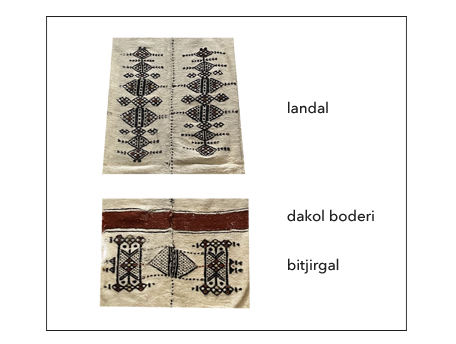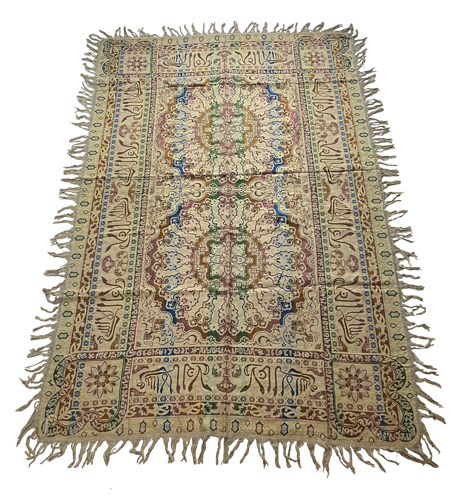Landaka Khasa |

Fiber_007098 Khasa Blanket; Fula People; wool; 9 ft x 4 ft (243.8 x 121.9 cm) private collection of Walter Logan Fry |
Landaka Khasa Detail |

The Fula, often called Fulani, is an ethnic group in the Sahara, Sahel and West Africa. They live mainly in West Africa and northern parts of Central Africa. A significant proportion of the Fula - approximately 7 to 10 million people (about a third of the population) - are pastoralists. The Fula are almost entirely Muslims. As pastoralists, they have a wide variety of wool products for use in weaving. The most important product of Fulani weaving is the "khasa blanket"; and the khasa blanket collected in Liberia by Walter Logan Fry is one of the most impressive items in his collection, albeit the red dye in the "dakol boderi” (see below) caused serious deterioration of the blanket all across the band, and there are other areas of deteriration, as well. The motif design of a "khasa" blanket contains a wealth of meanings. The pattern at the bottom of the fabric is called "bitjirgal", a water receiver that drops water from a container to the ground. A symbol of motherhood and fertility, it shows a woman's sexual organs (central diamond), as well as her shoulders, hands and feet (smaller diamonds and connecting lines). The wide red stripe above the bitjirgal is called "dakol boderi. This pattern illustrates the mouth (red stripe), the gums and the teeth (black lines and white dots) of the woman. Above the dakol boderi in this khasa blanket is the central design element, called “landal.” It is the largest and most impressive element of the blanket. The towering black lines hold the routes for herd migration to search for food. The peaks represent the hills on which shelters are built to provide protection to withstand the annual floods. This cloth is an expression of individuality and recollection for the Fula. Source: Bachelor Thesis of Annekathrin Schmid. Saxon University of Zwickau, Zwickau, Germany. Registration and identification number: 27561/ 082981. July 2, 2012. The textile below is a khasa blanket in the Minneapolis Institute of Art. |

khasa blanket; Fula People, Mali: wool; 105 x 53 in. (266.7 x 134.62 cm) Gift of Roberta and Richard L. Simmons Collection of the Minneapolis Institute of Art Accession no. 86.100.40 |
Moorish Tapestry |

Fiber_007099 |
The textile above is not a product of Liberia, and may in fact have been purchased in the Canary Islands on Walter Logan Fry's voyage to Liberia, or in Europe, on his way home two years later. As shown on the textile's tag, it was made in Italy, but the design, with central mandalas and border with Islamic calligraphy, is often associated with the Moorish tapestries of Spain. For comparison, the tapestry below is described as a 1920s Moorish Islamic tapestry with Arabic writing, Granada, Spain. Unlike the Fry textile, it has a single mandala, which is more typical for the design. |

1920s Moorish Islamic Tapestry with Arabic Writing, Granada, Spain |